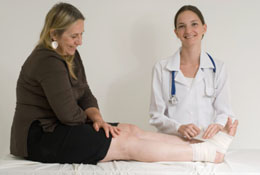The recovery from a hammertoe surgery can take a few months to even a year. The following Buzzle article will list out the varied factors involved in the postoperative care and recovery.

Hammertoe is a type of a deformity of the feet and is named thus because it resembles the clawed section of a hammer. In this, the person's toe is bent downwards towards the end because it contracts at the joint in the middle. Hammertoe is sometimes also known as hammer toe, claw, or mallet toe. This condition usually afflicts the second, third, or fourth toe.
While there are home remedies and other, simple treatment forms available, surgery (though the last option to choose from), sometimes, needs to be carried forth.
Hammertoe Surgery
If none of the conditions that lead to a hammertoe can be treated via regular methods, then a surgery needs to be carried through to treat the same.
There are a number of ways in which this surgery is done. Usually a tendon transfer is carried through. Other than that, a digital arthroplasty or digital arthrodesis can be undertaken as well. The former involves working the tendon for correcting the bend, while the latter involves the removal of the bone from the joint for rectifying the hammertoe. In very serious cases, the tendon on top of the toe, and the joint at the ball of the foot have to be released so that the toe can straighten through.
Causes• Wearing ill-fitting shoes
• Wearing high heels
• Flat feet
• Pressure exerted on a bunion
• Injury to the foot
• Diseases like arthritis and diabetes that affect the joints and feetThe Recovery Process
The recovery of the surgery involves a few stages. Post surgery, the person will experience swelling and pain in the operated area. The overall recovery time could span anywhere around a few months to a year.
►
Swelling and Pain
As mentioned earlier, post surgery recovery will involve varying degrees of pain and swelling. Pain killers will be prescribed for the same. To help further, the foot needs to be kept elevated so that the swelling subsides. The foot may need to be kept elevated for a few weeks after the surgery.
►
Crutches and Bandages
Post a hammertoe surgery, special dressings will be applied to the area which will be required to be worn for a couple of months during the recovery time.
►
Splint
In case soft tissues were shifted during the surgery, then a splint will be given in order to limit foot movement. In such a case, the majority of healing will take place within the first few weeks.
►
Footwear
It is important to wear the right kind of footwear, especially after the surgery. Most often, specialized surgical shoes or boots, which are soft-soled and comfortable, will be provided. These will aid in walking. These have to be worn for a few months post surgery. The doctor may also advice against the use of narrow and high-heeled shoes. The doctors may also ask the patient to wear a cast, depending on the condition of the foot.
►
Exercises
The orthopedic surgeon will also prescribe some specialized exercises to increase flexibility and help in faster recovery. He may also advice the patient to keep moving the toe such that it provides a stretch and leads to an increase in the range of motion and flexibility.
As the recovery progresses, the person will be able to bear more weight on the feet. This will depend on the progress of the foot and how far it has healed. In the same vein, a person can also begin to drive within a few days after the surgery depending on the healing process.
Other than these factors, the recovery will also depend on the age, sex and the overall health of the person.
At the end of the day, avoid stressing your toes too much, and most importantly, make sure that you do not bump the compromised toe while going about your activities. Keep a close watch on any discomfort or unusual pain in case of any complications.
Disclaimer:
The information provided in this article is solely for educating the reader. It is not intended to be a substitute for the advice of a medical expert.


 Hammertoe is a type of a deformity of the feet and is named thus because it resembles the clawed section of a hammer. In this, the person's toe is bent downwards towards the end because it contracts at the joint in the middle. Hammertoe is sometimes also known as hammer toe, claw, or mallet toe. This condition usually afflicts the second, third, or fourth toe.
Hammertoe is a type of a deformity of the feet and is named thus because it resembles the clawed section of a hammer. In this, the person's toe is bent downwards towards the end because it contracts at the joint in the middle. Hammertoe is sometimes also known as hammer toe, claw, or mallet toe. This condition usually afflicts the second, third, or fourth toe.